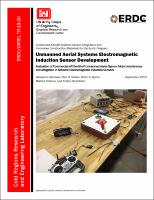Please use this identifier to cite or link to this item:
https://hdl.handle.net/11681/34104| Title: | Unmanned aerial systems electromagnetic induction sensor development : evaluation of commercial-off-the-shelf unmanned aerial system motor interference and mitigation in airborne electromagnetic induction sensors |
| Authors: | Barrowes, Benjamin E., 1973- Glaser, Danney R. Quinn, Brian G. Prishvin, Mikheil Shubitidze, Fridon |
| Keywords: | Electromagnetic induction Improvised explosive devices Permafrost Remote sensing Unexploded ordnance Unmanned aerial systems Unmanned aerial vehicles |
| Publisher: | Cold Regions Research and Engineering Laboratory (U.S.) Engineer Research and Development Center (U.S.) |
| Series/Report no.: | Technical Report (Engineer Research and Development Center (U.S.)) ; no. ERDC/CRREL TR-19-20 |
| Abstract: | The U.S. Army Cold Regions Research and Engineering Laboratory (CRREL) is supporting the U.S. Air Force Civil Engineer Center through research and development of an unmanned aerial system (UAS)–mounted electromagnetic induction (EMI) device capable of localizing embedded unexploded ordinance (UXO) for expedited runway and military range remediation. While EMI sensors exist for UXO detection, there are currently no UAS-based EMI systems that can provide this remote characterization of UXO with a near-real-time target classification. Developing and delivering this capability will provide a distinct improvement in soldiers’ ability to quickly and efficiently recover from an attack. Additionally, no expeditionary solutions presently exist for mapping of permafrost extent from medium-scale airborne platforms. This capability will allow lateral mapping of permafrost for impact assessments of construction activities, in a cost effective, standoff platform. This study used the CRREL-Dartmouth-developed EMI sensor to measure the fields emitted by two different UAS motor configurations at varying standoff distances ranging from 0 to 53 cm. The minimal platform-to-sensor standoff distance was determined to be 60 cm for the planned frequency ranges. This specification will be used to design and construct the frame that carries the EMI transmitting and receiving sensor on the bottom of the UAS system. |
| Description: | Technical Report |
| Gov't Doc #: | ERDC/CRREL TR-19-20 |
| Rights: | Approved for Public Release; Distribution is Unlimited |
| URI: | https://hdl.handle.net/11681/34104 http://dx.doi.org/10.21079/11681/34104 |
| Appears in Collections: | Technical Report |
Files in This Item:
| File | Description | Size | Format | |
|---|---|---|---|---|
| ERDC-CRREL TR-19-20.pdf | 11.34 MB | Adobe PDF |  View/Open |